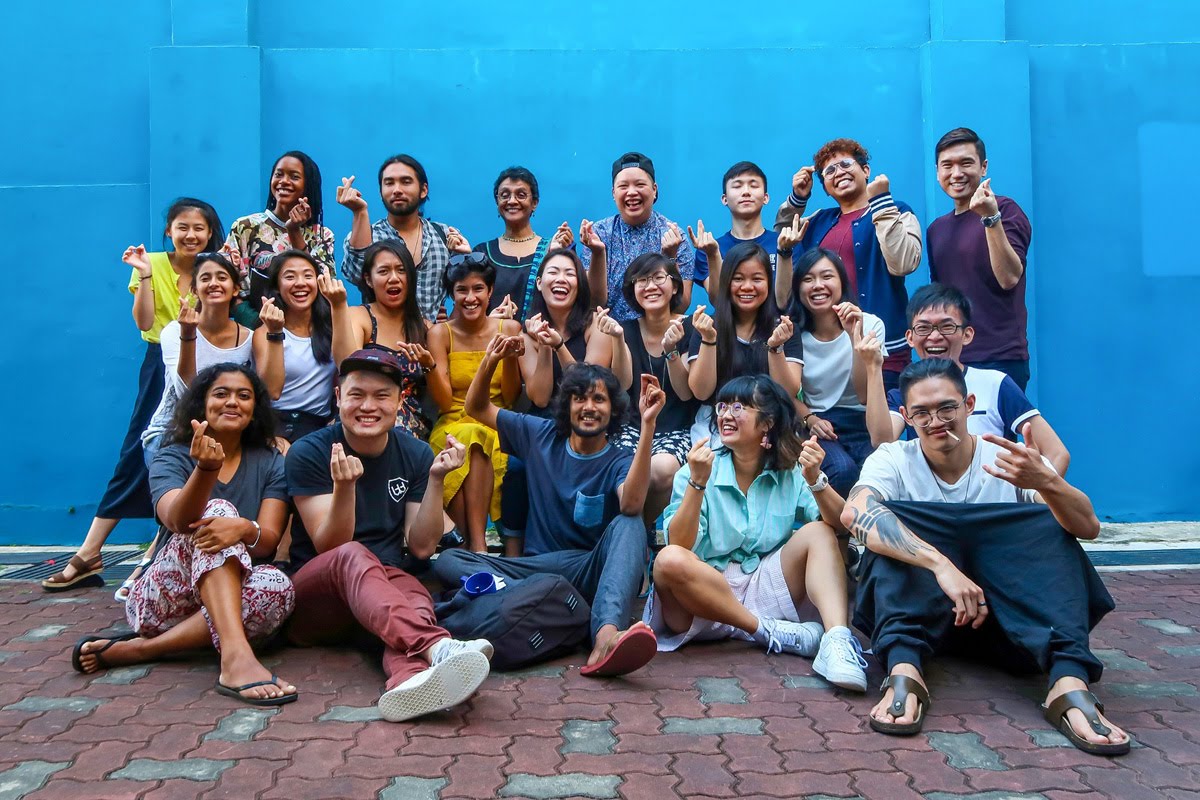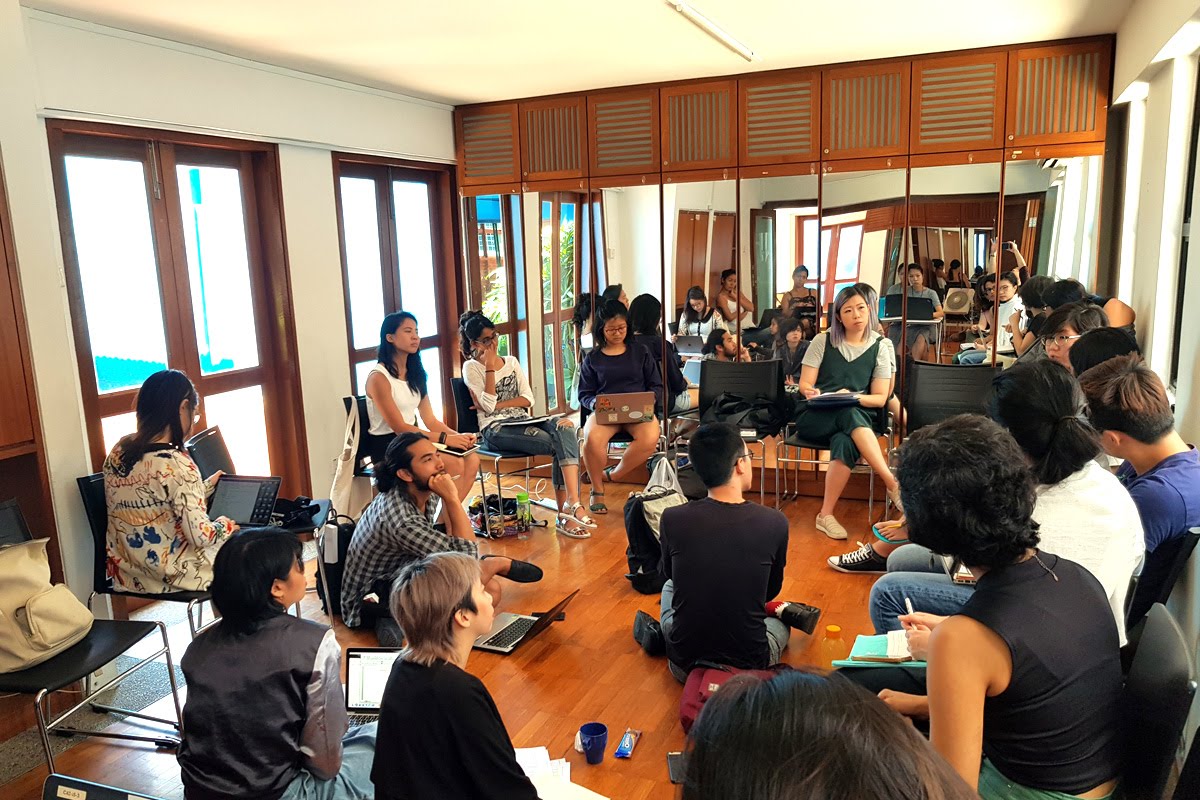The Performance Making group after the last P/M workshop.

Day 6 Activities:
- P/M Workshop with Corrie Tan
- P/M Workshop 3
- SIFA Performances: The Blues Project / 0600
An art maker and an art critic are often caricaturised as mortal enemies, an adversarial relationship in which the former creates work and the latter seeks to tear it apart.
But in today’s performance writing workshop conducted by arts writer Corrie Tan, an actor met her critic. And the moment was beautiful.
A few participants from the Performance Making (P/M) track decided to drop in on their Performance Writing (P/W) counterparts in the workshop; Shannen Tan was one of them. In a discussion of whether performance makers actually used feedback in a review, Shannen revealed that one of the P/W participants, Casidhe Ng, had reviewed her performance in the lead role of a campus production of Furthest North Deepest South in 2015.
“[National University of Singapore] is not an actors’ school and I wanted to be an actor,” Tan said. “I was like, oh my god, I think this will help me decide if I want to make it in the theatre industry as an actor, because I don’t know if I can make it.”
“And then, Casidhe wrote my first review.”
Ng was reviewing the production for Centre 42’s Citizens’ Reviews programme. The two had never met before.

A more somber moment during Corrie Tan's writing workshop.
Tan continued, “He wrote this little snippet of me... and it brought me so much joy. I didn’t say I was an actor, [but] he called me an actor!”
“And he compared me to [the actor] Fanny Kee and I was like –” She gave a yelp of joy and the room burst into laughter and cheers.
Ng told his side of the story: “I was in my final year and I was doing a paper on The Finger Players.” The Finger Players is the theatre company that had created and produced Furthest North Deepest South in 2004.
“I saw a recording of [the 2004 production] and tied it to Shannen’s performance.”
“That’s even better!” Tan exclaimed. “He knew what he was talking about!”
“I think this interaction has just pointed out a symbiotic relationship where an actor is feeling legitimated by a critic, and then the critic is also legitimated by the actor,” facilitator Corrie Tan summed up. (To find out what else happened during the workshop, see the P/W blog coverage of Day 6.)
Later that day, the P/M participants met in a workshop to examine their relationship with something more abstract – space.
In a warm-up activity, facilitator Charlene Rajendran had the group on their feet in a circle. The task was for one person to walk up to another person in the circle, with hands cupped together, and offer that person a word. That person would then locate another person and pass on another word, and so on and so forth.

Warm-up activity at the Performance Making workshop.
Rajendran changed up the rules for subsequent rounds. First, she allowed the group to use only words associated with a space they would visit to rejuvenate themselves. Words then became statements to complete, statements about their relationship to the city, for example, “My city is...”
Thoroughly primed to think about space, the group then embarked on four rounds of intense discussion, interrogating performances spaces and Singapore as both performance makers and audience members. Grounding the session was the concept of the city – as explored in Carol Martin’s article titled Performing the City– as a simultaneously material and imagined space, influencing the creation and consumption of performances, and shaping audience behaviour.
The performance maker’s relationship with the audience emerged as one significant discussion thread, among many, for the young performance makers. “How much responsibility do we want to give to audiences, not in co-creation of the work, but in bringing a presence that is rich [to the performance]?” Rajendran prodded. Below are a few selected responses:
“There needs to be more audience competence for theatre,” Nathaniel Tan responded. “But with that, what is the onus of the theatre maker to create art that caters to different levels of the competence?”
Tan Liting said, “At least for myself, I want to go [into a show] with a curiosity. And I hope my audience has that curiosity too. Is it our responsibility as performance makers to create that curiosity? I don’t know... It’s difficult to expect things of audiences, but I think the bare minimum would be some interest or curiosity.”
“What are the rules? Who are the rules for? Is it for audiences? Or to protect the performers?” Chia Xin Ying questioned.
Iwani Zoe Mawochi said, “Sometimes I feel we’re so reverent to the work that we create or the work of others that we place these chokeholds, that respect is tantamount to a good performance. I don’t think that’s necessarily normal.”
“Are we confusing or conflating the idea of respect from the audience with obedience and compliance from the audience?” Victoria Chen said.
The end of the 3-hour workshop marked the last time the P/M group would meet on their own, for the final three days of the Points of View journey would be undertaken together with the P/W participants.
To sum up the vast array of ideas and experiences the P/M participants had been through together over the past six days, Rajendran said: “Being in touch with different points of view, no matter how different or similar, hopefully makes us aware of the different points of view inside us. That there is that questioning, that there is that capacity to disagree with ourselves, and to not be too worried about it.”
Over the past two evenings, the P/M group watched the site-specific production 0600 at the National Gallery, and American music and tap-dance performance The Blues Project at Victoria Theatre. The POV participants will further discuss the former work in an upcoming seminar, but here are some initial thoughts from a few of the participants about both productions:
Irfan Kasban on 0600: “I think the romanticising of 'site-specificity' needs to be reevaluated. The work was at most 'site-inspired' or 'site-reliant' as specificity entails acknowledging the current site, not what it used to be.
Gabbi Wenyi Ayane on 0600: “I felt it hard to empathise with most of the characters because their monologues lacked nuance, or because they weren’t telling me things I didn’t already know. I felt like as a piece of theatre, its job wasn’t to give me facts (I can Google what!) but to help me empathise with both sides of the argument and I thought the piece failed in that respect. I didn’t need to be given statistics, I needed to hear the humanness in both arguments.”
Ng Sze Min on The Blues Project: “I enjoyed seeing and hearing tap shoes as an instrument, especially the call and response between the singer and shoes. The singer would present a melodic motif that the tap dancer would pick up rhythmically. Then the dialogue would begin. Different parts of the shoe also had different timbres, so a different movement had to be made to change timbres.”
Pooja Mohanraj on The Blues Project: “It was for me a celebration of the spirit of coming together and being together. More than the craft itself, I saw a spirit of sharing and it is always amazing to watch performers loving what they do. That is why I loved the work. I felt replenished.”
POV continues with Day 7's joint-track activities.
Published: 10 May 2018